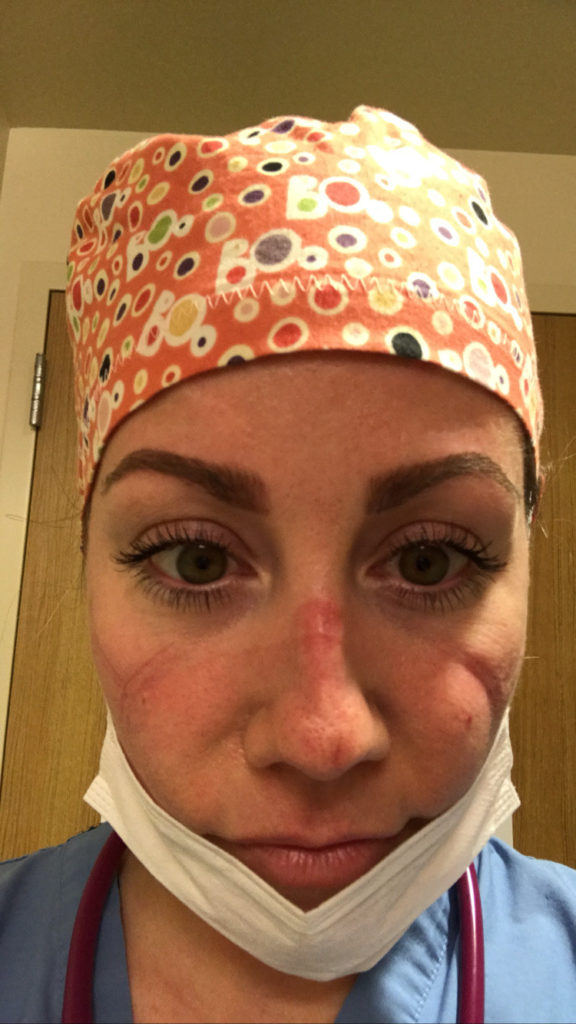
Heather, an emergency room (ER) nurse, is no stranger to high-stress situations. “I’ve worked in the neonatal intensive care unit; I’ve worked in the pediatric intensive care unit; I used to ride in the helicopter to pick up kids in emergencies.” She has worked in pediatric care for 10 years, most recently in a pediatric ER in southern New Jersey.
But Heather volunteers to go into the adult ER now, where they are receiving and treating COVID-19 patients. She says most of the hospital has been converted to caring for coronavirus cases and that the ICU is overwhelmed. The current situation is different from anything she’s ever experienced. “The atmosphere is tense,” she says. “Everyone is stressed, and patients are scared. You don’t see an end in sight.”
Each day, Heather goes into work and dons a gown, gloves, hair covering, goggles, an N95 respirator and a surgical mask. She says that during nursing school, she learned about wearing N95 respirator in case they were caring for a patient with tuberculosis. “In my 10 years as a nurse, I’d only worn an N95 respirator once. We’d get fitted once a year, but that was it,” she says.
Now, she wears one respirator almost her entire shift, and has recently had to start reusing the respirator she’s worn previously. Some days she and her coworkers wear their PPE for six hours straight, taking only one break during a 12-hour shift – not drinking water, not sitting down – and it takes a toll.
Challenges of the Current Crisis

One of the challenges that Heather is dealing with is slight bruising and irritation to parts of her face that are in contact with the respirators and goggles she is wearing for very long periods of time. . It eventually fades, but “it’s exhausting,” Heather says. “When you put the respirator on, you feel pressure.” For her, the hardest part is the feeling of breathing air held close to her face. She compares it to having your head under a blanket, breathing hot air and feeling a sense of claustrophobia.
She puts the feeling aside while she’s at work. It’s part of the overall strain that she and her fellow healthcare workers deal with every single day. She says they talk to each other about ways to cope and try to keep each other strong. “I don’t tell my family what it’s like in the ER because most people wouldn’t be able to deal with it,” she says. “If I went to a therapist and told them what I experienced, I think they would need therapy.”
Nurses – The Ultimate Caretakers
Heather is often one of the few people patients physically get to see given limitations on hospital visitors. It is emotionally taxing on patients and the care team. “Patients are alone and scared, often struggling to breathe and needing life-saving measures. This is not what we are used to. This is not how we do things. Our patients don’t deserve to be without their family.”
Heather knows she could work in the calmer pediatric ER – and she has several good reasons to want to play it safe. She is a mom to three children ages 14, 11 and seven, and her parents both have health conditions that make them especially vulnerable. “We can’t see them,” she says. “They used to come over and cook dinner for my kids. Now, they just drive by in the car to wave, and we all end up crying.”
Even though she knows she’s putting herself at risk – and is writing a will for the first time because of everything she has witnessed with COVID-19 – she says that when this is over, she wants to know that she did everything she could to help. When she sees her fellow nurses working long, exhausting shifts, she is going to be there with them.
“We are going to continue to do it, even with lack of PPE. This is what nurses do. We step up, even when we risk our own lives,” Heather says. “We’re here and we will continue to be here for everyone who needs help. We are all in this together.”
Here are some tips that can help with respirator use:
- Pick a respirator that fits you comfortably.
- Pay attention to any discomfort or pain associated with the respirator or any protective equipment you may be wearing. This is a warning signal of potential pressure injury or skin damage.
- Do not overtighten the straps of the respirator. This has the possibility of affecting the seal of the respirator and potentially increasing the risk of a pressure injury.
- Adjust the headbands so they are in the correct position. This will help maintain a proper respirator seal and pressure on the face.
- As soon as you can exit the hazardous area, remove the PPE to help relieve any pressure and friction from your respirator.
- Protect your skin from excessive moisture and friction.
- Select an alternative style of respirator such as reusable respirator with a synthetic rubber or silicone faceseal, or a Powered Air Purifying Respirator (PAPR) which utilizes a hood that does not tightly seal to the face.
We want to hear your story from the frontlines of the COVID-19 battle. Reach out to us here.
